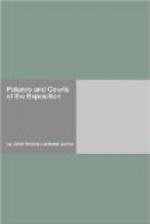The Spanish Cavalier (by Allen Newman) is the type of man who came to America in the 16th century, during the period following its discovery. He is the type of Spanish conqueror (conquistador).
The Pirate (by Allen Newman) is the type of man who infested the shores of Spanish-America and preyed upon the commerce.
The Palaces are intimately placed for several reasons.
From experiences at previous Expositions “tired feet” are strongly to be considered, hence the nearness of the buildings.
San Francisco has a few (?) windy and foggy days in the Trade Wind Season, so if the walls are high and near together, the courts on the inside of those walls will be well protected from both winds and fogs. The high walls lift the cool air so that it passes over the buildings of the great block, thus sheltering the courts within.
-
Now that you have walked around the façades of the palaces of this great block system, you can start with your courts.
I would strongly suggest that you study all of your buildings of this group first, before entering the courts for close work.
-
The Aisles Between the Palaces
The aisle between the Educational Palace and the Palace of Food Products is called The Aisle of Spring, tho the name will probably not be applied very often, as the aisle is not important.
The flora seen here is eucalyptus, acacia, laurestinus with its white bloom, and veronica decussata with its purple flowers.
The border is cistus.
-
The Aisle of the Setting Sun is between the Court of the Universe and the Court of the Four Seasons.
The Aisle of the Rising Sun is between the Court of the Universe and the Court of the Ages.
These two aisles are very much alike, the great difference being in the flora used.
The style is Italian Renaissance and should not be called Venetian, as many have named it.
The walls are covered with a diaper design of ochre, pink and travertine.
Blue rondels are used with telling effect. They give a delightful touch of color and have a fine Italian feeling. These rondels have no special meaning, being purely decorative.
The coupled columns with different decorations have their prototypes in the columns of the churches of southern Italy.
The arched windows have interesting grotesque keystones.
Notice that the spirals of the great Siena marble columns turn in opposite directions. Think how they would appear if they all turned the same way!
Notice also the beautiful manipulation of color on the Triumphal Arches.
The latticed windows are strongly suggestive of Mohammedan work and are a beautiful turquoise green. They are among the many Oriental touches at this splendid Exposition. The area of deep pink and the burnt orange medallions must be seen to realize their beauty.




